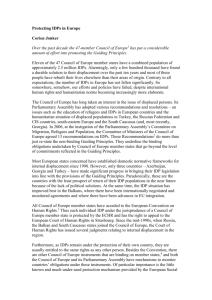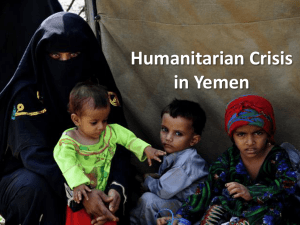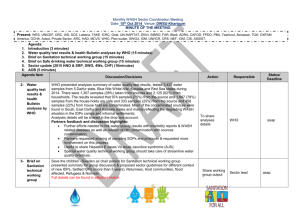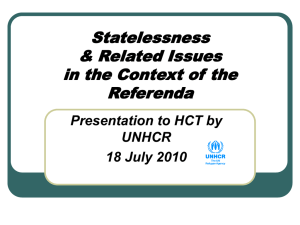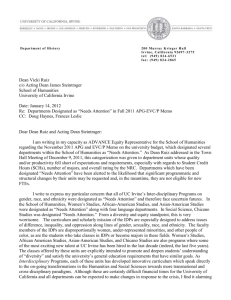Western_Cape_Rapid_Assessment_Report
advertisement
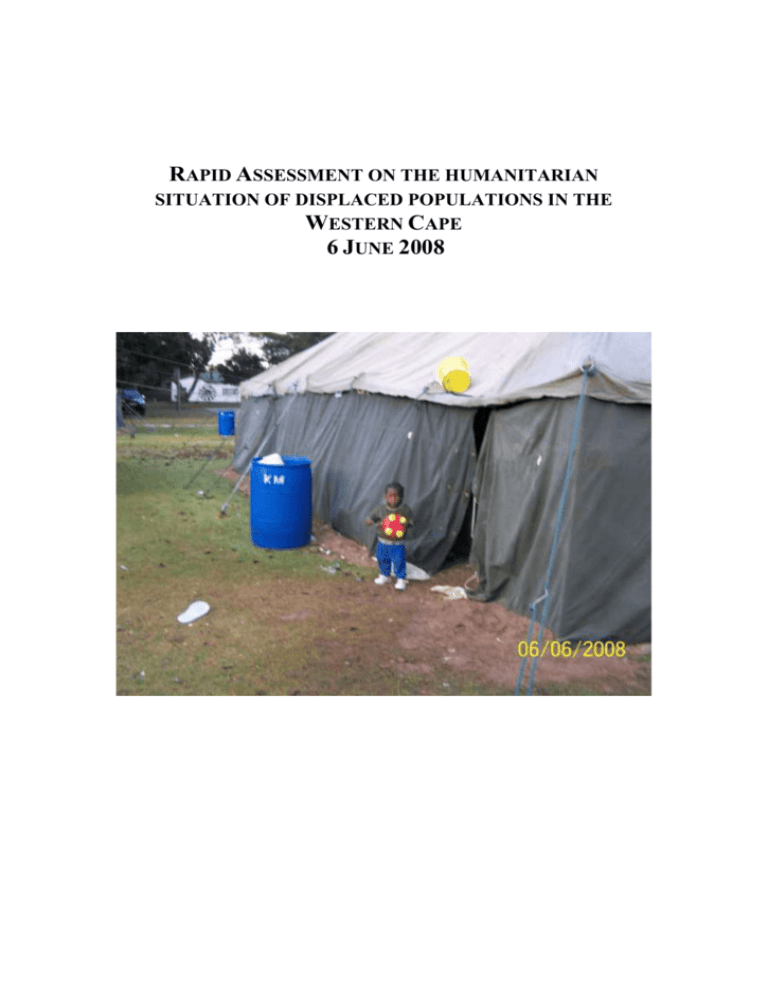
RAPID ASSESSMENT ON THE HUMANITARIAN SITUATION OF DISPLACED POPULATIONS IN THE WESTERN CAPE 6 JUNE 2008 1. BACKGROUND The attacks on foreign nationals, which occurred in the Western Cape between 22 and 25 May 2008, led to the displacement of about twenty thousand people. This followed similar attacks that led to the displacement of about 18000 people in Gauteng Province. In order to facilitate a coordinated response and resource mobilisation, the Western Cape Province declared an emergency on 2 June 2008. Unlike Gauteng province where more than 40 deaths were recorded, the situation in the Western Cape was not characterised by high levels of violence and destruction. However, about five deaths were recorded. A number of people sought refuge in community halls, churches and some were provided with shelter at existing sites. The response was led and coordinated by the provincial government through the Office of the Premier, the Provincial Disaster Management Centre and the City of Cape Town. Several organisations including faith based organisations, NGOs, the affected municipalities of Cape Town and individuals offered humanitarian assistance in the form of food and non food items, shelter, water and sanitation as well as health services. However, in the sites beyond the metropole, there is a visible lack of organization, food suppliers, and community and business involvement. The levels of humanitarian assistance continue to be varied with some centres of temporary shelter offering better services while others do not meet minimum standards for dignified living. In order to have a clear understanding of the humanitarian situation in current sites where people are sheltered and to define a way forward the Provincial Government requested the UN to assist in conducting a rapid assessment. The assessment was carried out to achieve the following objectives: a. To better understand the current humanitarian situation of the displaced people b. To identify needs and gaps in humanitarian interventions c. To make recommendations to address immediate humanitarian needs that may also inform medium to long term planning. 2. METHODOLOGY An inter-agency assessment team facilitated the process comprising of the following organisations: United Nations Office of the Coordination of Humanitarian Affairs (UNOCHA), UNICEF, WHO, International Organisation for Migration (IOM) International Federation of the Red Cross and Red Crescent (IFRC) and South African Red Cross Society. The Provincial Government provided logistical support, while social workers from both government and NGOs assisted with the collection of information. A sample of 26 sites was selected through purposive and systematic sampling. The determinant variable for site selection was the number of displaced people at each site with all large sites being targeted first, diversity as determined by nationality and culture, the location in relation to basic services and other residential centres as well as the type of accommodation provided. Focus group interviews were conducted in the sites with cross sections of community members belonging to various nationalities in addition to interviews with the site management and NGOs working in these sites. 2 Some of the limitations of this assessment include: the large populations in some sites such as Soetwater with close to 3000 people which could not be counted; displaced people not found at centres since some go to work during the day and come back at night, no proper records kept at some centres making it difficult to determine the exact numbers of displaced people or the activities occurring at the sites on a daily basis. 3. FINDINGS 3.1. General overview The sites are very variable in size with population ranging from 45 to more than 3000 people. Most of the sites are in Cape Town metropole while there are a number located quite a distance from the metropole. Many NGOs, Red Cross, religious organizations and individual people have been providing assistance and are involved in the management of the temporary shelters. A number of sites are becoming smaller on a daily basis due to a combination of factors mainly as a result of successful reintegration processes. There are still a considerable number of challenges in some of the larger sites particularly Soetwater that is isolated from basic services and communities. While this assessment focused on the humanitarian situation of the IDPs, it was evident that the predominant concern of the people in the sites was about the possibilities of relocation, reintegration and repatriation. During the process of the assessment, there were reports of reintegration in many sites. However, there were also IDPs who wished to be repatriated to their home countries or a third country. These are matters that UNHCR, IOM, the RSA and the affected embassies must affect systematically but urgently. Clear communication in this regard must reach the affected populations soonest. All service providers and site managers should operate from a uniform understanding of these key messages in order to defuse misinformation and facilitate planning and implementation of government’s next phase. 3.2 Demographic Information as of 3-5 June 2008 Sites names Females Silver stream 39 Summer 47 Greens Table View 2 Harmony 169 Sarepta 76 Desmond Tutu 95 Site B 43 Khayalitsha Andile Msizi 62 Solomon 48 Mahlangu Masibambane Males 135 142 Children 25 20 Total 202 209 75 667 14 128 35 1 35 12 27 37 78 871 104 71 16 25 182 144 46 0 46 250 115 3 Zolani Phillipi East KTC Blue Waters Portland mosque Bothasig His People Light House Soetwater Youngsfield Bellville mosque Knysna Sedgefield 78 48 80 56 76 68 145 190 150 80 59 104 165 150 350 300 12 162 18 38 11 25 50 40 59 300 130 11 192 127 250 246 150 150 224 283 2801 630 300 185 18 For some of the sites visited the information was not available. Data on the numbers of IDPs are being collected by the City of Cape Town, the Provincial Disaster Management Centre, the Department of Home Affairs and the Provincial Government. Although the numbers from these information sources exist, the reliability is compromised by a number of factors e.g, the IDPs are moving around sites and as a result may be counted twice, some work during the day or night and still others refuse to provide information. Some people are already reintegrated into the communities from where they were displaced. Some have also returned to their home countries. The following sections of this report deal with the specific aspects of the humanitarian conditions of the IDPs in the Western Cape, including protection, food, shelter, water and sanitation and health and nutrition. The report is concluded with a set of key recommendations. 3.3 PROTECTION The protection assessment focused on physical safety, the protection of women and children and abuse and exploitation. 3.3.1 General protection measures The displaced peoples are accommodated in varying locations both geographically and in terms of the types of accommodation. The majority of the 79 sites are in the Metropolitan of the Western Cape Province with a minority of sites in the West Coast and in the Southern Cape. The biggest site is Soetwater with an estimated number of 3000. There are 6 other big sites, with between 250 - 1000 people, and a number of smaller sites with 45 to 200 people. In general, the numbers are beginning to dwindle as a result of voluntary repatriation and reintegration. The security is generally optimal with security guards at most of the access points and visible police presence within or near the entrance of the sites. The Department of Safety and Security has also deployed “Bambanani” safety volunteers in some of the 4 sites. Most of the sites are enclosed. The physical location of the Soetwater site is problematic. The relocation of people must be considered as a matter of urgency. The site is damp, cold, isolated and next to the sea. Should the weather get worse it will pose a secondary emergency. The Knysna site is also just a few meters from the lagoon. The ground is wet and freezing cold, with the result that the mattresses are soaking in water. The people are cold and ill. This site should also be relocated as a matter of urgency. The IDPs at all the sites indicated that they were feeling relatively safe with no immediate threats of violence while they were in the sites. Most are still very anxious about mobility beyond the sites. Particularly the people in the bigger sites, which are also those furthest from the communities from which they were displaced, are fearful and feel trapped. Several would like to venture out to shops or other facilities but can’t risk this. They do not wish to have any contact or interaction with the local communities. However, there are many reports of people returning to the communities where they are welcomed back. Still others go to work on a daily basis and return to the sites after work. In terms of violence, there were no incidences reported within the sites, other than one account of domestic violence which was dealt with appropriately. Within the sites the relationships amongst the varied nationalities seemed to be amenable with joint activities and cooperation in the management of the sites visible. However, there also seems to be an overt ‘gate keeping’ of access to certain groups. In some instances this mobilization has taken the form of an alternative “regime/management” which controls what is said and agreed upon. For example, the Somali population, which constitutes the majority in some sites, all indicated that they are extremely unhappy in the present situation. They wished to be repatriated to another country or even Somalia and that this should be organized by the ‘UN’. They have subsequently refused help from government and resist the access of government officials responsible for the delivery of essential services. Keeping such large populations in one location with such strong leadership may constitute a security risk. 3.3.2. The protection of women and children In some of the sites visited, the sleeping quarters of women and children are separated from those of men. However, in many of the sites men and women were sleeping in either the same hall or tent. This is highly problematic and places women and children at risk and compromises the privacy of all. In some areas there were limitations regarding sanitation and amenities, e.g. not enough toilets, or in some instances showers and toilets were shared by both men and women. In some cultures this is unacceptable and in some instances women are taking showers in their tent. The conditions, apart from privacy, at the community centres and religious halls are remarkably better than those at the larger tent sites. The people also generally appear to be much more settled and calm. In most sites the children looked well dressed and energetic, mostly playing around, in some instances without visible supervision. This is a situation that must be monitored and adult supervision secured. In the Youngsfield site some women and children are being taken to homes in the nearby community at night due to cold conditions in the tented site, and brought back in the mornings. However, with the worsening weather conditions, all tented sites will be 5 extremely cold and wet. Consideration should be given to moving people out of these tented communities as soon as possible. During the visits, we received several reports of people who lost their relatives and are unaware of their well being or location. For example, a man reported that his 3 year old son had gone missing. In another site a woman with a young infant reported that she had been separated from her husband during the displacement. There are a number of people with disabilities in the sites. At Soetwater there are three people needing immediate attention. In Andile Msizi, Khayalitsha there are seven blind males and four blind women. The Department of Social Development are ensuring that pregnant women and those with young babies are removed with their families to more suitable locations. There are plans for a special health facility for mothers with new born babies. There are also concerns about the special needs of infants and small children (see health and food report). With regard to psycho - emotional wellbeing, it is imperative that decisions are made about the future of individuals and groups in a participatory and non confrontational way. Presently there is very little communication happening between the state and the IDPs. This leads to misinformation and instability. There is also limited access to and psycho social services on sites. There has been one report of a suicide attempt as one IDP jumped from the roof of one of the community halls. It is evident that a large number of the affected people will remain in South Africa. Therefore a long term policy and integrated implementation strategy should be in place within the next months. This should be communicated to the affected people and the South African population as a whole. In the short term the site conditions and in particular the management of the sites must be addressed. The coordination and administration of the various aspects of site management is poor. This leads to insecurity and tensions among the role-players and between service providers and IDPs. There were no reports of any sexual violence during the site visits. But the women were saying that they still feel that they cannot walk around in the sites because they just don’t know what can happen. They were also very upset that they are sharing tents with men at some sites. 3.3.4. Education There are large numbers of young children between 1 -10 years in the sites. Children are mostly playing on their own with no educational stimulation or visible structured activities. In some sites, e.g. Harmony Park there is a designated educational space (tent) for structured educational activities. Early Childhood Development (ECD) kits could be provided by UNICEF with coordination and support from NGOs. Most of the children at the sites do not attend school either because they are too far from the schools which they attended before, or their parents don’t want them to go because they fear attacks on their children or there is no transport provided. In some sites there were elementary educational activities being organized by volunteers to keep the children busy. In one or two sites the Department of Education was involved. In some 6 sites the Department of Social Services seems to have a daily presence. Based on the success stories of reintegration, maybe caution should be exercised with the establishment of full educational facilities at the sites. Most of the sites have the potential of creating safe spaces for young children to play and learn. This is important for their psychosocial and physical wellbeing and should be a standard provision. Many hundreds of youth, especially young men, are sitting around idle. Activities or educational programmes could be organized with their active participation. 3.3.5 General comments and recommendations on protection and education The conditions regarding protection and education within the smaller community based sites are in general remarkably better, cleaner and safer than the larger sites. Consideration must be given to relocation of the IDPs to smaller sites as these are rapidly being vacated as a result of the reintegration process Women and young children should preferably be accommodated with families in communities. Ensure that a child protection plan is developed, awareness raised about the special vulnerability of children and a referral system put in place at each site. District social development offices must follow-up cases and reports on missing persons, separated families and persons with disabilities. ECD kits should be secured and distributed within an organized way to sites with support from an ECD service provider. UNICEF is ready to provide assistance in this regard. Ensure safe places for children to play and learn. The Soetwater IDPs: consider urgent plan of relocation to and within small groupings of people closer to local communities. Deploy social workers to sites for individual and family support to address the needs of individual families pertaining to their future options. Ensure that they get the necessary training on these options from Dept of Home Affairs. They need to work closely with the officials of Home Affairs. The Department of Home Affairs must be capacitated and supported to fast track the process of registration; and with linking those IDPs who wish to leave, with their embassies. For ongoing intervention the social services workforce in general must be trained on working with foreign nationals living in South Africa. 3.4. FOOD Food is a basic need for human survival. The current attacks on foreign nationals left thousands of people homeless and without food overnight. Many, gripped by the fear of losing their lives, left behind their belongings, cash and food stocks. Most of them, during the initials days faced enormous difficulties to find food and shelter. Through the generosity of various religious organizations, local philanthropists and government the immediate needs for food were met. 3.4.1. Information Sources Records at sites on food utilization and stocks were hard to obtain as no records were maintained properly. Similarly, cooked foods were provided in all sites which were 7 prepared by the catering companies at locations far from the sites, thus no access to their records was possible in the limited time available. Both men and women from different nationalities were interviewed to assess their food preference, taste, quantity received and their adequacy to their need, quality of food provided and problems related to distribution and timing of distribution. 3.4.2. Food Supplies and Distribution No proper records of food received and distributed were maintained in the sites, therefore, the utilization of food could not be determined. In all sites, cooked food was provided by catering companies or voluntary organizations that was prepared away from the sites and served at different intervals to the IDPs. In some big sites, two meals were provided. Lunch was served around 11 a.m. and included four slices of bread and juice or tea and sometimes fruits. The menu of supper varied almost every day and included rice, pap (maize meal), spaghetti, and chicken or meat. Due to the distance the supper was often served cold. Some smaller sites managed by religious organisations received better meals in terms of quantity, quality and frequency- there was a preference for cooked food, three meals a day including breakfast. For example, the Somalis received rice, spaghetti, chicken and meat and sometimes fish. The sites run mainly by religious organizations, though small in size, are faced with funding problems as voluntary contributions are drying up with each passing day. The lack of breakfast in most of the sites was a great concern raised by the IDPs. Little variation in meals menu, untimely availability of meals and quality of meals were concerns of a large portion of the population. 3.4.3 Changes in Dietary Habits Most of the sites have mixed populations of different nationalities who have diverse eating habits and taste preferences, thus, one common dish could not satisfy everyone in need. In general, most African nationals like meat and chicken. Somalis in particular prefer rice and spaghetti. Congolese and Rwandese staple diet is rice, fish, chicken, potatoes, beans, cabbage and spinach. Some communities liked soft pap while others thick. The variation in taste and dietary habits across different nationalities viz a viz one common dish served to all was not widely appreciated. The cooked served meals normally include pap, soup with little meat/ chicken and potatoes. Despite reservations over the variety and menu of cooked meals, only a few cases of people having stomach problems due to food were reported in some sites. Milk for children and for tea/ coffee was not provided on a regular basis. Some mothers also requested milk for their children. Due to varied tastes and eating habits, women recommended that dry rations should be provided instead of cooked food so that they can feed their families according to their own taste and requirements. However, this is not possible for the time being as the majority of the families lack cooking facilities and kitchen utensils. 3.4.4. Problems with Food The efforts of government, local communities, philanthropists and religious organizations are commendable as they responded timeously to provide food and 8 relief supplies. The quantity of food, particularly in the cold weather, needs to be enhanced as the IDPs mentioned they feel hungry between the meal intervals. Similarly the lack of breakfast in many sites and lack of diversity in the food basket according to the tastes of the population were common needs expressed across all the sites. In many instances the people complained that the food is too spicy. In some sites food that was beyond the official expiry date was distributed. This raises mistrust and frustration among the IDPs. Food is distributed by the organizers and everybody is required to collect his/ her food. Despite the minimum role of the committee in food distribution, the IDPs have no complaints over the mechanism of food distribution. There are also few reports of discrimination in food distribution either by nationality, gender or age group. In some sites, the quantity of food is sometimes short and some people who will be queuing may not get their share. In one site, the beneficiaries also complained about corruption in food distribution and lack of proper hygiene in food preparation. 3.4.5. Challenges The government, local communities, philanthropists and churches and mosques have been at the forefront providing immediate relief and food assistance thereby averting a humanitarian catastrophe. The voluntary nature of assistance driven by humanitarian imperative has been the key to respond to the immediate crisis. With the passing of time, voluntarism is fading. It is therefore essential that a system of funding and systematic food management should be in place to fill the gaps that are expected to arise. There is also a need for proper record keeping reflecting food receipts and distribution. The overall food management including daily dietary requirements and the oversight of a nutritionist should be immediately ensured. As the humanitarian situation continues, the need for dry rations will become more cost effective and easier for the families to cook food according to their own taste, needs and timing. In that case, provision of cooking facilities and kitchen utensils needs to be addressed. 3.4.6. Recommendations on food An adequate funding mechanism should be in place particularly for the sites managed by religious groups as their sources of funding are drying up. The option of providing dry rations instead of cooked meals should be worked out in order to meet the taste needs and dietary requirements. This can only be achieved if cooking facilities, kitchen utensils and an energy source for cooking are provided. Optionally IDPs can be involved in the preparation and cooking of the wet feeding for the site. Breakfast should be included in the meal basket and meals with diversified menu should be introduced taking into account the dietary habits of the site population. The nutrition needs of pregnant women, nursing mothers and children should be considered and supplementary food should be provided for vulnerable groups. 9 3.5. A proper record keeping system must be introduced to track food utilization in all sites. SHELTER Displaced people are sheltered in different types of shelter that include large and small tents, community halls and churches. Some of the tents at sites such as, Blue water, Youngsfield and Soetwater were leaking and did not have adequate insulation against cold wind. The situation at Knysna, Youngsfield and Soetwater which are on low lying areas pose risks and could lead to health problems if not properly insulated before heavy winter rains fall. Some of the tents have bad lighting even during the day. There is no privacy in some of the shelters with both male and females staying in the same tent or community hall. In some settlements, for example Blue water, windows and doors are broken. Most of the church buildings, such as the Bellville sites, are warm and secure with adequate toilet facilities, lighting and access control. Living space is adequate but there is a general lack of privacy in these big halls. However, in sites such as Soetwater there is visible overcrowding. In most of the sites visited, the main concerns are lack of beds or mattresses and warm blankets for the cold winter. Very few blankets were provided and some IDPs shared the little available. Other issues that were not also considered for most of the sites are sanitary wear for women and nappies and potties for children. 3.5.1. 3.6. Recommendations on shelter The overcrowding in some of the large tents needs urgent attention and where possible families, should stay together. Proper site planning and erecting of tents is needed to reduce the water soaking in tents as well as possible flooding and leaking. Need to consider issues of privacy and cultural differences when providing communal shelter so as to reduce tension, abuse or exploitation. More lighting required in some shelter. Provision of sanitary wear to women. More blankets particularly during the current cold winters. WATER AND SANITATION 3.6.1. Water Overall the water and sanitation is no major concern. The water in all sites visited is provided by the City of Cape Town, usually through existing town water supplies. The water of the town is chlorinated. There were no reports of lack of water nor reports of long waiting times at water points. No jerry cans or buckets for water storage have been distributed. 10 3.6.2. Sanitation In most sites there are enough latrines to cover the needs of the IDPs. In many of the sites (town halls and tent sites) there is a combination of the so-called mobilettes and permanent flush latrines. Few of the mobilettes have hand washing facilities nearby. Only in the tent sites are the toilet facilities separated for men and women. Most of the permanent latrines are for men or women only. While the permanent latrines (flush latrines) are usually cleaned daily often by contractors, the mobilettes are cleaned some times twice per week but often only once. Many of the mobilettes were dirty. In some of the sites soap had been distributed while in others there is none. Most but not all of the sites have some shower facilities. At least two sites visited have hot water in the showers. Some of the tent sites do not have separate showers for men and women. In Youngsfield (a site with tents) all showers are in one mobile building as there is no separation between men and women. Somali women are refusing to use this facility and are taking baths in their tents. Most IDPs are washing clothes in their own washing basins; no water buckets were provided and in most of the sites washing soap was not distributed. A number of sites visited were clean with garbage usually being collected by the municipality. However many were dirty. There was no hygiene promotion or health education activities on most of the sites visited. 3.6.3. Recommendations on water and sanitation Water In the sites a distribution of jerry cans will be useful to ensure better hygiene in the tents Water near the latrines is required to facilitate hand-washing after latrine use. In some sites drainage at the water points will need to be improved Sanitation The Mobilettes will require more regular cleaning. The distribution of potties could be considered for small children. In more permanent sites latrines could be allocated for one or two tents (but again separated for men and women) to try to ensure better use. Consider the involvement of IDPs to set up such a system. A distribution of washing basins for the cleaning of clothes is required in the sites with tents. Showers Separate shower facilities are required for women and men, especially in the Somali culture it is not acceptable to let women and men share the same shower or latrine Hot showers though difficult and expensive to install and maintain will ensure better hygiene and provide some warmth against the cold weather. 11 Garbage collection Most of the sites are really clean. Involve the IDPs more in cleaning their own environment. Ensure sufficient dustbins are available especially at the tented sites Hygiene promotion and distribution of hygiene kits Hygiene and health promotion activities are needed and it will require a specialist support from relevant authorities to determine the relevant messages for the different groups affected. Hygiene kits should be distributed and during the distribution it should be made clear for how long the items are supposed to last (e.g. 250gr of soap per person per month) 3.7. HEALTH AND NUTRITION 3.7.1. Health Situation At the time of the site visits, the overall health situation of displaced population was satisfactory. However, there is variation in the provision of services. There is no outbreak of communicable or acute diseases in the sites. Children are reported to be vaccinated and the coverage is fair in sites where stationary health facilities are functioning. No child and maternal mortality were reported in the sites. Access to health services, in some sites where medical services were not available, has been difficult despite the fact that referral systems existed. However, the IDPs indicated that they did not feel safe to go out of the site to seek medical services since some nationals still insult and threaten them. Common acute diseases in the sites were reported: flu, coughs and sore throats which could be attributed to the cold weather. Diarrhoea and dehydration were reported due to spicy food in one site. Chronic diseases like TB, diabetes, epilepsy and high blood pressure were reported. The latter was the case particularly among the adult population than the children. In most cases HIV status was not disclosed. In the Harmony Park and Sarepta sport complex sites, ARV treatment is administered at both sites. There is also a psychosocial support system in place at these sites. The population expressed concern over the little appropriate medicines available and the quality of the health care services. Proper health services are lacking in centres such Khayelitsha, Desmond Tutu, Site B, Andile Msizi, Solomon Mahlangu, Masibambane and Blue Waters. 3.7.2. Nutrition and Antenatal Services The nutrition situation of children under 5 is reported to be generally satisfactory, but some serious concerns should be addressed. Infant formula is not available in most sites assessed. In some sites, baby formulas are also distributed, but in some cases it was beyond the expiry date. In some instances antenatal and post natal services are provided to pregnant and lactating mothers where medical facilities exist. In Summer Greens, no antenatal 12 service is available for pregnant women and there is no supplementary ration for them. 3.7.3. Recommendations on Health Provision of medical services is not uniform in all sites. A coordinated system should be developed and a minimum standard of services at sites should be agreed upon. The Department of Health should play a leading role in this. Mobile clinics with all the essential drugs should deliver health care in sites without a clinic on site, as most IDPs still fear to attend municipal clinics. Psychosocial support through counselling for stress shock and traumatism should be provided due to prevailing fear and stress. Reinforce the referral systems for serious illnesses, obstetrical emergency or other emergencies where needed. Identify HIV positive people and continue their care. Strengthen health information surveillance system to early detect any outbreak or quick increase of diseases. Further investigation at Summer Greens, Soetwater for the diagnosis of the general itching and arrange treatment accordingly. 4. KEY RECOMMENDATIONS The main recommendations for consideration are provided below. The thrust of this assessment was on immediate life saving humanitarian interventions that should be guided by humanitarian principles and the reduction of the possible worsening of the current situation. Some of the areas that need urgent attention include: Decongesting of some of the mega sites particularly Soetwater where tensions are mounting. The site is currently isolated from any services and far from communities making the IDPs feel like prisoners and totally removed from the community they are supposed to be part of in the long run. The high population in an area that was meant to cater for a few tourists also runs the risk of ecological disasters with reported cases of sewer bursts very close to the sea. Too many groups of different nationalities staying in different sites with different religious and cultural practises can also worsen tensions. The situation at Soetwater must be defused urgently. New/existing smaller sites in the province should be identified and people moved. Urgent training and strengthening of site management systems: In most of the sites, there is very poor to non existent overall management. There is limited record keeping and administration; site infrastructure and maintenance, including access control, registered numbers of IDPs; control over the quality, quantity and type of food commodities brought in and distributed. Training in humanitarian principles and minimum standards in disaster response (Sphere) for organisations currently managing the sites is imperative. In some areas, IDPs were provided with stale food and food they 13 were not very familiar with, limited non food items like blankets, overcrowded in a single tent and families separated even in cases where it is possible to have families together. The basic minimum standard of IDPs participating in design, implementation, monitoring and evaluation of assistance needs to be adhered to reduce tension. Strengthening coordination and information particularly at district level: While provincial and district coordination structures are well functional, in some districts organisations that come to deliver assistance particularly in church based sites do not reflect proper coordination systems. There is an urgent need for at least one centralised point to ensure standardised response. Some organisations come in with different individual interests and at times give conflicting information to IDPs e.g. on issues of repatriation. It is important for UNHCR and IOM to continue active engagement with the displaced people to clarify and support the activation of available future options. Strengthen the capacity of the Department of Home Affairs to conduct the registration and documentation tasks required. Support their function of linking IDPs to the appropriate embassies to facilitate voluntary return of citizens who express interest and are not refugees. Information should be provided to the people on the process and where possible, embassies need to visit some of the sites to provide information on repatriation. This will assist in decongesting some of the sites and also reduce anxiety that may lead to tension. It is important to note that as part of the international community, organisations should be guided by the humanitarian Charter, which is based on the principles and provisions of international humanitarian law, international human rights law, refugee law and the code of conduct for the International Red Cross and Red Crescent Movement and Non Governmental Organisations in Disaster relief. Hence the need to reassert the right to life with dignity for disaster affected populations (Sphere). Annex: Questionnaire 14
